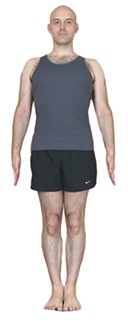
Tadasana (Sanskrit: ताड़ासन, romanized: Tāḍāsana), Mountain pose or Samasthiti (Sanskrit: समस्थिति; IAST: samasthitiḥ) is a standing asana in modern yoga as exercise; it is not described in medieval hatha yoga texts. It is the basis for several other standing asanas.
Etymology and origins
Tāḍāsana is from the Sanskrit words ताड tāḍa, "mountain" and आसन āsana meaning "posture" or "seat". Samasthitiḥ is from सम sama meaning "equal", level", or "balanced"; and स्थिति sthiti, "standing".
The pose was unknown in hatha yoga until the 20th century Light on Yoga, but it appears in the 1896 Vyayama Dipika, a manual of gymnastics, as part of the "very old" sequence of danda (Sanskrit for "staff" or "stick") exercises. Norman Sjoman suggests that it was among the poses adopted into modern yoga as exercise in Mysore by Krishnamacharya to form the "primary foundation" for his vinyasas with flowing movements between poses. The pose was then taken up by his pupils Pattabhi Jois and B. K. S. Iyengar, into their worldwide Ashtanga Vinyasa Yoga and Iyengar Yoga styles respectively.
Description
Tadasana is the basic standing asana on which many other poses are founded. The feet are together and the hands are at the sides of the body. The posture is entered by standing with the feet together, grounding evenly through the feet and lifting up through the crown of the head. The thighs are lifted, the waist is lifted, and the spine is elongated. The breathing is relaxed. It is used in some schools of yoga in between other poses, to allow the body and consciousness to integrate the experience of the preceding asana and to prepare for the next.
Variations


Placing the feet wider is common in vinyasa styles of yoga and provides a more stable base in this and other such standing asanas.
Namaskarasana, Pranamasana, or Prayer Pose has the hands in prayer position (Anjali mudra) in front of the chest.
Pashchima Namaskarasana or Reverse Prayer Pose has the hands in prayer position behind the back.
Urdhva Vrikshasana, also called Urdhva Hastasana or upward tree pose, has the hands stretched straight upwards, and the gaze is upward to the Angusthamadhye Drishti (thumbs). The pose occurs twice in Ashtanga Yoga's Surya Namaskar.
Parshvasana (Side Stretch Pose), also called Indudalasana, known from 1968, has the arms lifted and the body stretched over to one side.
Anuvittasana or Hasta Uttanasana (Standing Back Bend), has the arms raised and the back arched. An extreme form of the pose is Tiryang Mukhottanasana, in which the back bend is sufficient to enable the hands to grasp the ankles.
Some reclining asanas such as Supta Tadasana (Reclined Mountain Pose) stem from Tadasana.
Iyengar Yoga
Iyengar Yoga considers Tadasana pivotal as the foundation of most standing asanas. It teaches practitioners to balance the weight equally on the two feet.The feet are placed together, the shins and thighs are aligned, and the chest is lifted. The pose is not distinguished from Samasthitih. The arms can be raised over the head or kept at the sides of the legs. It appears in the 1st and 2nd weeks of Iyengar's āsana courses as detailed in Light on Yoga.
Ashtanga Vinyasa Yoga
In Ashtanga Vinyasa Yoga, Tadasana is performed on the toes, while Samasthitiḥ is flat footed. In this style of yoga the two āsanas are different. Samasthitiḥ is the centerpiece of the standing sequence and the foundation for the:
- Hasta Vinyasas (arm vinyasas)
- Parsva Bhangi (side vinyasas)
- Uttanasana (forward bending vinyasas), and
- squatting/hip stretching asanas
In the standing sequence, the final asana of the series (before Savasana) is Tadasana, performed on the toes. In this school of yoga, Tadasana is the beginning and ending asana in the warm-up Surya Namaskar sequence. It is sometimes interspersed throughout Ashtanga Series when full vinayasas are used, and it is the foundational pose for all standing asanas. The Nasagra Drishti at the tip of the nose is considered the correct drishti for Tadasana. Sushumna drishti is encouraged to draw the awareness inward. The school considers Uddiyana bandha, Mula Bandha and Jalandhara Bandha appropriate for Tadasana.
See also
References
- "Yoga Journal - Mountain Pose". Retrieved 11 April 2011.
- Saraswati, Swami Satyanand (1969). Asana Pranayama Mudra Bandha. Bihar: Yoga Publication Trust. p. 142. ISBN 978-81-86336-14-4.
- Ranjini 2012, p. आसन entry.
- Sinha 1996, p. 18.
- Ranjini 2012, p. समा entry.
- ^ Steiner 2012, p. Samasthitih.
- Ranjini 2012, p. स्थिति entry.
- Sjoman, Norman E. (1999) . The Yoga Tradition of the Mysore Palace. Abhinav Publications. pp. 54–55, 100–101. ISBN 81-7017-389-2.
- ^ Iyengar 2005, p. 41.
- Fitz-Simon 2010, p. Standing Poses: Tadasana (Mountain Pose).
- Kaminoff 2007, p. 39.
- ^ Ramaswami 2005, p. 3.
- Steiner 2012, p. Urdhva Vrikshasana.
- Majumdar, Sachindra Kumar (1968). Yoga for physical and mental fitness. Stravon Educational Press. p. 80.
- Rhodes, Darren (15 February 2013). "Yoga Sequence for Change: 5 Steps to Parivrtta Paschimottanasana". Yoga Journal. Retrieved 8 February 2019.
- Kline, Sarah. "Standing Back Bend • Anuvittasana". Yoga Today. Retrieved 8 February 2019.
- MacGregor, Kino (2017). The Power of Ashtanga Yoga II: A Practice to Open Your Heart and Purify Your Body and Mind. Shambhala. p. 205. ISBN 978-0-8348-4124-6.
- Fitz-Simon 2010, p. Supta Tadasana.
- Iyengar, Gita S. (2000). Yoga in Action for Beginners. Mumba i: Yog Mumbai. pp. 13–14. ISBN 81-87603-01-1.
- Iyengar 2005, p. 131 (Appendix: āsana courses).
- Mehta, Silva; Mehta, Mira; Mehta, Shyam (1990). Yoga: The Iyengar Way. New York: Dorling Kindersley. p. 18. ISBN 0-679-72287-4.
- ^ Ramaswami 2005, p. 1-34.
- Maehle 2011, p. 880.
- Ramaswami 2005, p. 2.
Sources
- Iyengar, B. K. S. (2005). Illustrated Light on Yoga. HarperCollins. ISBN 978-81-7223-606-9.
- Sinha, S. C. (1996). Dictionary of Philosophy. Anmol Publications. ISBN 978-81-7041-293-9.
- Kaminoff, Leslie (2007). Yoga Anatomy. The Breath Trust. ISBN 978-0-7360-6278-7.
- Ramaswami, Srivatsa (2005). The Complete Book of Vinyasa Yoga. Da Capo Press. ISBN 978-1-56924-402-9.
- Maehle, Gregor (2011). Ashtanga Yoga Practice and Philosophy. New World Library. ISBN 978-1-57731-986-3.
- Steiner, Ronald P. (2012). "AshtangaYoga.info".
- Ranjini, V. V.; et al. (2012). "SpokenSanskrit Dictionary".
- Fitz-Simon, Witold (2010). "Yoga Art and Science".
| Yoga as exercise | ||||||||||||||
|---|---|---|---|---|---|---|---|---|---|---|---|---|---|---|
| Topics |
|  | ||||||||||||
| History |
| |||||||||||||
| Schools (Gurus) |
| |||||||||||||
| Related | ||||||||||||||
